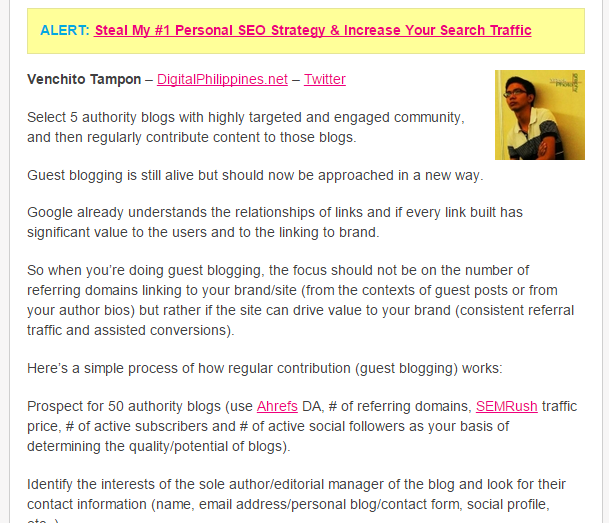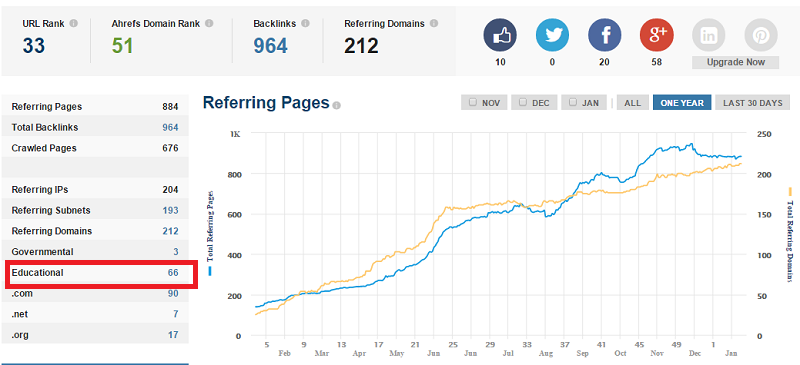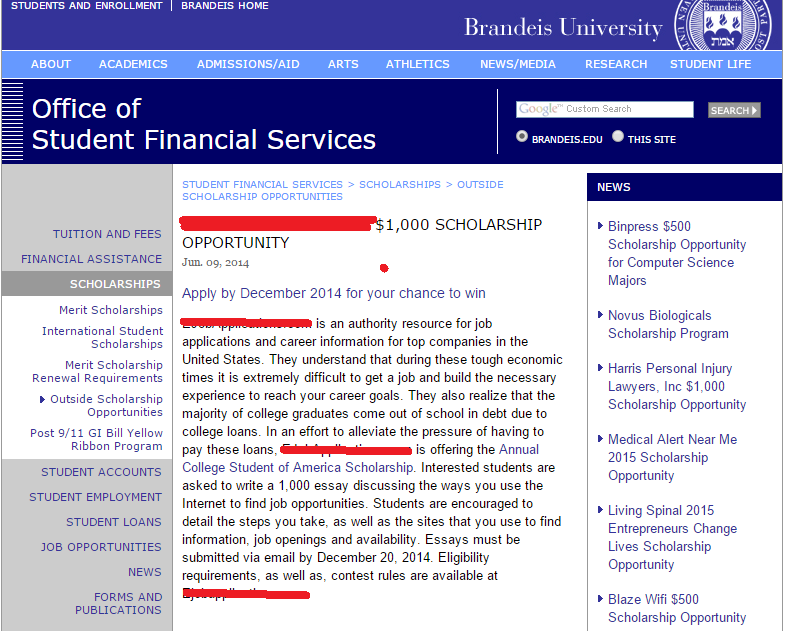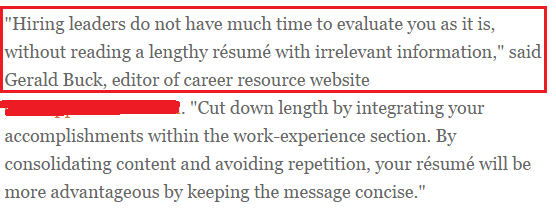by Venchito Tampon Jr | Last Updated on October 24, 2021
Editorial links are the most powerful type of links given that it signals Google that the brand being linked to is a trusted resource/reference (either it is targeting the homepage of the site or its inner pages/contents).

There are three primary elements that can intensify your chances of getting in-content links for your website:
- Strong direct relationships with bloggers and content publishers in the industry.
- Content seen has a uniquely useful information and unexpected hook, which edges the content piece over pages hosted on competitors’ sites.
- The brand has a large influence over its community through its published high quality content and coverage/mentions from popular news/media outlets – which makes it easy for the brand to be remembered by top media/content publishers when writing posts for their blogs/sites.
Acquiring contextual links editorially from content creators requires extensive amount of effort and time especially for websites who’re still starting out to build their influence and authority from scratch.
Tactics that aim to consistently attract editorial links to your content/site would usually take 4 to 6 weeks or even months for brand new websites. Though they’re all time-consuming, these tactics that I’ll be sharing to you are not impossible to do.
1. Trust marketing
Without trust, it is almost impossible to earn and editorial links, simply because content creators are keen to choosing credible sources/pages that they’d like to mention in their future works.
Trust marketing brings edges to new brands without enough to content to compete in the industry. With proper engagement and content development, new websites can now attract in-content backlinks from industry-related publishers with trust as its main component of link attraction.
Personalize your brand by choosing one team member (prefer it to be your site’s content creator) to spend most of his/her time producing high quality content pieces that’ll be published inside and outside of your company website.

Get him/her engage in niche-specific community platforms like forums and Q&A sites by providing direct and useful answers to topical questions in your industry. Spend at least hour every week for community engagement, because you’ll learn great insights from this activity – i.e. understanding the deepest needs of your target users, which you can use to create a user-generated content that targets a specific group of users (mostly potential linkers).
Wil Reynolds shared a very interesting presentation on conversion-oriented forum link building. He specifically discussed one ecommerce client who generated $11,000 revenue from a simple one-hour a week forum engagement.
Trust marketing can also yield contextual links from brands (with pre-existed relationships) through interviewing one of your brand publishers in their own blogs.
2. Invest in scholarships programs
For brands with big marketing budgets, setting up a scholarship program and publishing a page on it is one of the effective ways to earn reputable backlinks nowadays. Educational institution sites and government pages tend to link to scholarship programs that provides intrinsic value to their target visitors and users.
Though most of the time there’s only link that can be built from a single domain using this link acquisition technique (scholarship link building), still the relevant traffic and assisted conversion it can bring to the website are very much promising for the business.
This client of mine in the education niche acquired 62 .edu links through its scholarship program – which adds hundreds of referral traffic to his website and helps the site rank for relevant industry keywords.
You can request for a profile section from your target linker to explain more details about your program. This will entice users from other sites to visit your scholarship page and contact you for future partnership programs (this might get you additional editorial links from potential linkers).
3. Do secondary-competitor reverse engineering
Competitor backlink building is not just creating a huge list of backlinks earned/built by competitors but also understanding the relationships of linking pages and the page/site being linked to.
Reverse engineering (other term for competitor backlink building) can provide you an easy way to earn your first set of links (without need to prospect for targets from scratch).
The most common reverse engineering method is finding websites that currently rank in search results for your target keywords (either these keywords are commercial, transactional or blog-related).
Though this approach is pretty much powerful for local-based businesses, adding a few more ways to improve your reverse engineering process is definitely worth to try out in order to lessen footprints caused by building links also gained by your competitors.
Target links seen in resource pages as your secondary competitors when doing reverse engineering activity.
You can build a larger list of link prospects using this approach given that most of the time, links in those resource pages are not visible in search results.
Use Ahrefs, OSE or other third-party link analysis tools to track existing links of those secondary competitors. You can apply any of the following link tactics to acquire those editorial links:
- Pitch webmasters who have resource pages with broken links in them and ask if they’ll be interested to replace their defunct links with hyperlinks pointing to your website and to your other suggested resources (choose non-competitor links as your other suggested links, so as not to help your competitors gain the same amount of links your brand is getting).
- Contribute on industry blogs that have high search share and engagement level to build recurring links to your content(s) every week/month. Ask their content managers if you can apply to become their regular content contributors.
- Understand how your primary competitors (prospected from search results) and secondary competitors (other links in your target resource pages) acquired their current editorial links. They may have used any of these tactics: moving man method, press pitching or social link building.
Once you’ve created a giant list of link prospects through reverse engineering, you can now create a link strategy/plan to build those in-content links.
4. Profile editorial links from content contributor/speaking opportunities
A brand ambassador with a superb expertise in an industry often receives speaking and content contribution opportunities because he is recognized as one of the top influencers through his valuable contribution on top industry blogs and his non-profit social and community engagement.
Target corporate speaking and authority blogs for speaking and content contribution opportunities since most of the time, they allow individual profile pages for each of their contributors/speakers which’ll make it easy for target participants and readers to know more about their authors/speakers.
Other opportunities to earn editorial links from profile pages include:
- Sponsorship and exhibit programs for local and international events, which allows sponsors to expose their brand to a wide variety of potential customers/clients both offline and online.
- Local or international volunteerism on popular events with an opportunity to be mentioned in a volunteers’ list (specific brands) in a separate page of their website (there are cases that they also publish profile pages for brands who volunteered to the event).
Invest in networking with other brands in your industry (should be non-competitors) to earn unexpected in-content links from voluntary events in industry-related events and seminars.
5. Quoted insights
In today’s digital marketing, content creation is now a requirement for every brand who wants to build and earn non-manipulative links from reputable websites/blogs.
When producing high quality content, it is imperative to add unique insights/quotes coming from your brand ambassadors and content creators in order to make your content comprehensive to read or to consume.
This approach allows you to earn voluntary-given backlinks from bloggers and researchers who want to use your content creator’s quotes/insights contained in your content.
Make a consistent effort to produce high quality content on your website that have information that is found nowhere else (this element is commonly called unexpected hook).
6. Optimize your pages for natural language optimization type
Natural language patent was released last November as a method for Google to extract data from an authority page listed in search results in order to provide a direct answer to a specific search query.
This allows many authority pages to be seen by new search users as a recommended answer for a specific questions/query.
Add information to your page that is straightforward and that suits a specific search query or keyword phrase (e.g. symptoms of diabetes).
You can link to your page from other related internal pages in order for your new visitors to see your main target page. This will also help the page to increase its page authority and rank for that specific query.
This approach may help your page be seen by researchers or bloggers in that specific area, which will eventually help your content to earn editorial links from their blogs/sites.
Here are other resources that you can check out for more information on this topic:
- Direct Answers: Extracting Text From Pages Citations
- Direct Answers: How Answers Are Extracted From Web Pages
- Direct Answers – Using Query Intent Templates To Identify Answers
- Direct Answers – Taken From Authority Websites
- Direct Answers – Natural Language Search Results For Intent Queries
More Resource: How To Promote Your Latest Blog Post Like A Boss
The Author
Venchito Tampon Jr
Venchito Tampon is a Filipino Motivational Speaker, Corporate Trainer, and a Leadership Speaker in the Philippines. He is the CEO and Co-Founder of SharpRocket, a link building agency. With a decade of experience, Venchito has a proven track record of leading hundreds of successful SEO (link builidng) campaigns across competitive industries like finance, B2B, legal, and SaaS. His expert advice as a link building expert has been featured in renowned publications such as Semrush, Ahrefs, Huffington Post and Forbes. He is also an international SEO spoken and has delivered talks in SEO Zraz, Asia Pacific Affiliate Summit in Singapore, and Search Marketing Summit in Sydney, Australia. Check out his other businesses, Hills & Valleys Cafe, Blend N Sips and Saas Pursuit.
How our LINK BUILDING AGENCY builds 250 links/mo consistently using Predictable Link Building Methodology™…
- Using a SIMPLE and PROVEN system
- Using a SCALABLE strategy
- No private blog networks
- No creepy outreach emails








